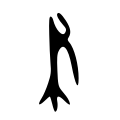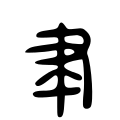Radical 129
Chinese character radical
| 聿 | ||||
|---|---|---|---|---|
| ||||
| 聿 (U+807F) "brush" | ||||
| Pronunciations | ||||
| Pinyin: | yù | |||
| Bopomofo: | ㄩˋ | |||
| Gwoyeu Romatzyh: | yuh | |||
| Wade–Giles: | yü4 | |||
| Cantonese Yale: | waht | |||
| Jyutping: | wat6 | |||
| Japanese Kana: | イツ itsu / イチ ichi (on'yomi) | |||
| Sino-Korean: | 율 yul | |||
| Names | ||||
| Japanese name(s): | 筆旁/ふでづくり fudezukuri | |||
| Hangul: | 붓 but | |||
| Stroke order animation | ||||
 | ||||
Radical 129 or radical brush (聿部) meaning "brush" is one of the 29 Kangxi radicals (214 radicals in total) composed of 6 strokes.
In the Kangxi Dictionary, there are 19 characters (out of 49,030) to be found under this radical.
聿 is also the 145th indexing component in the Table of Indexing Chinese Character Components predominantly adopted by Simplified Chinese dictionaries published in mainland China, with 肀 and ⺻ being its associated indexing components.
Evolution
-
 Oracle bone script character
Oracle bone script character -
 Bronze script character
Bronze script character -
 Large seal script character
Large seal script character -
 Small seal script character
Small seal script character
Derived characters
| Strokes | Characters |
|---|---|
| +0 | 聿 肀 |
| +4 | 肁 肂 肃SC (=肅) |
| +5 | 粛JP (=肅) |
| +7 | 肄 肅 肆 |
| +8 | 肇 肈 (=肇) |
Literature
- Fazzioli, Edoardo (1987). Chinese calligraphy : from pictograph to ideogram : the history of 214 essential Chinese/Japanese characters. calligraphy by Rebecca Hon Ko. New York: Abbeville Press. ISBN 0-89659-774-1.
- Lunde, Ken (Jan 5, 2009). "Appendix J: Japanese Character Sets" (PDF). CJKV Information Processing: Chinese, Japanese, Korean & Vietnamese Computing (Second ed.). Sebastopol, Calif.: O'Reilly Media. ISBN 978-0-596-51447-1.
External links

Wikimedia Commons has media related to Radical 129.
- Unihan Database - U+807F
- v
- t
- e
Chinese radicals according to the Kangxi Dictionary
- 211 齒
- 214 龠
See also: Kangxi radicals


















